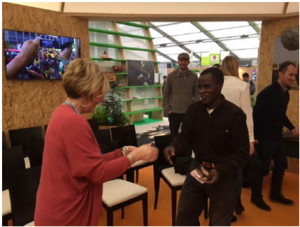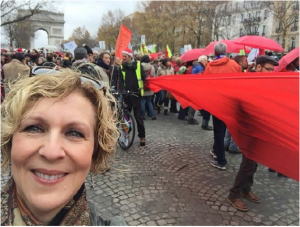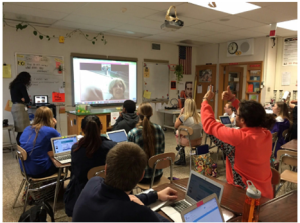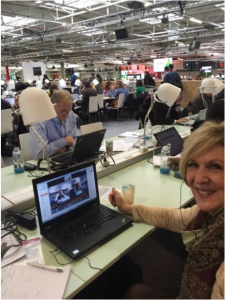By Leigh Foy, York Suburban High School Science Teacher
For the past 7 years, the American Chemical Society (ACS), the largest professional scientific organization in the world, has been sponsoring a program called The Student Climate Literacy project. Two York College chemistry professors, Dr. Keith Peterman and Dr. Greg Foy, started the program which each year selects 8 college students from across the USA and Canada to go to the annual United Nations Climate Change conference. The purpose of the program is for the students to attend the conference and to share what they have learned by being ambassadors for their home college campuses, writing a blog for students that the ACS supports (www.studentsonclimatechange.com), and communicating with young people all over the world through Facebook, Twitter, Instagram and Buzzfeed. In December 2015, the conference (called COP 21) was in Paris and it was historic because for the first time 195 countries agreed to limit their greenhouse gases in an attempt to stem the rise of global climate change. And this year a high school chemistry/biology teacher from York County got to accompany them – me!
Through a series of connections (yes, there are benefits to being married to an analytical chemist!) and serendipity, I was granted NGO (nongovernmental organization) status to attend the week-long conference in Paris. Suddenly, I was walking around the international meeting andbrushing elbows with world leaders (like Ban Kimoon, who smiled graciously at me when I took a picture of him walking by) and listening and asking questions of leading scientists from NASA and NOAA at the famed “Hyper Wall”. We saw an operating hydrogen fuel cell car and another car that had been “printed” in 8 hours by a 3D printer. We talked with a scientist from China who had invented paving material that “soaked up” atmospheric carbon dioxide. We saw roofing materials from a European company that incorporated solar panel technology. Many countries around the world are investing heavily in renewable energy technologies and these were all exciting to see and to report back to my students.
One of the NASA scientists that gave a presentation called, “What Happens in the Arctic Doesn’t Stay in the Arctic”, talked to me after the presentation and it turns out he is from Perry County, PA! He reacted like I was a rock star upon my introducing myself as “just a high school teacher” and said how lucky I was to be in a position to affect change for the future. He told me to tell my students to take as “many science classes as they could” because they will need them in the 21st century! Because of the NGO status I was also granted access to the press area and that was quite an experience. We (the college students, professors and me) attended press conferences, presentations by leading scientists, and experienced different perspectives of the world at each country’s pavilion. even managed time change difficulties and got to Skype with all of my classes back home. (see picture below of the international press area the COP)

Mrs. Foy meeting at COP21 with the Kenyan farmer, Kisilu, who is heading an effort for local farmers to plant trees.
One of the themes of this conference was indigenous people and the effect that climate change is having on their cultures. Alaska, for example, is experiencing the heightened effects of climate change due to its position near the north pole and accelerated polar ice cap melting. Other peoples are challenged by the changing rainy seasons and drastic precipitation patterns (drought and floods) that affect crop growth. We met with a Kenyan farmer named Kisilu, who is trying to persuade his fellow farmers in the region to plant more trees to help offset the effects of climate change. He traveled to the Paris COP21 to tell others of the hardships that climate change is leveling at the farming community in Kenya trying to grow enough food to sustain their families. (My husband and I wrote an article about this encounter that was featured in the Huffington Post.)
On the last day of the conference, there was a planned international demonstration to support the UN efforts to control climate change to be held at the iconic Arc de Triomphe. Because of the recent terrorist attacks in Paris, the demonstration was banned but that didn’t stop the thousands of people of all ages and from all over the world to come and peacefully march. We talked with our college student group and they were “all in” to participate in this march. We older people went with some trepidation, but thanks to a professional and flexible Paris police force, 10,000 marched in downtown Paris without incident or violence of any sort. (see picture right). On our way back from the demonstration we heard the news that the historic Paris Agreement had been signed!
One of the many things that I carried back with me was a scientist’s comment that the future holds many opportunities for those who are prepared with scientific knowledge. We teachers need to continue to help our students make real world connections to the challenges we face in the 21st century. I have never been more proud to be a science teacher, because we truly are in the trenches fighting for a scientifically literate population for our future.



